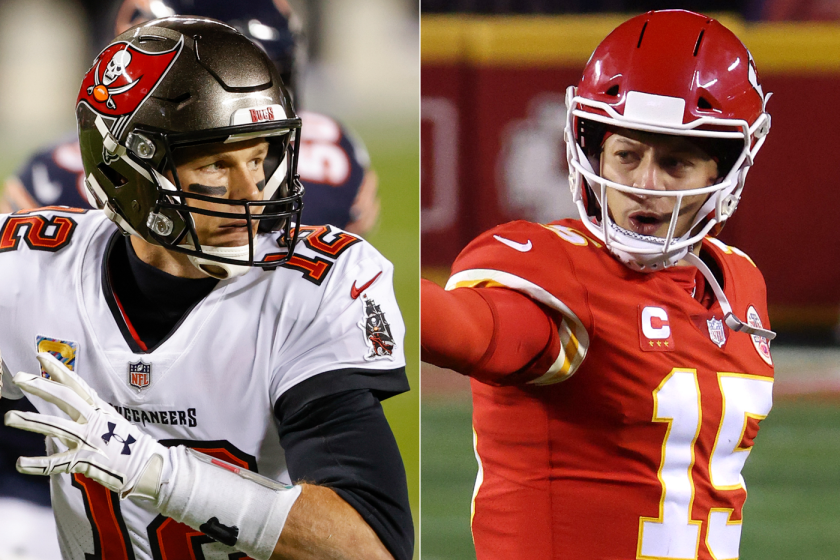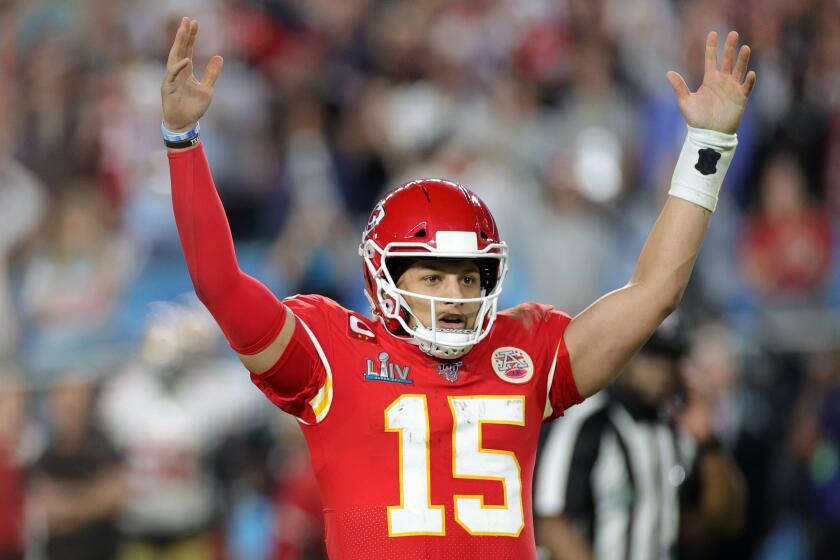Will the pandemic take the fun out of Super Bowl LV? Advertisers are cautious

- Share via
Former ad executive Donny Deutsch knows the power of an effective Super Bowl commercial.
In 2011, Deutsch’s New York-based agency delivered a spot showing a kid in a Darth Vader costume exerting his powers (with the help of his father’s keyless ignition control) over a Volkswagen Passat. The entertaining minute received plenty of free airtime and online shares after the game.
But if Deutsch were still in the ad business and advising clients about Super Bowl LV, his advice would be — stay away. He believes the public is still emotionally raw over a year filled with a pandemic, social justice protests and an ugly election campaign that was capped with a jaw-dropping attack on the Capitol by pro-Trump rioters.
Everything you need to know about the 2021 Super Bowl between the Chiefs and Buccaneers, including start time, location, TV channel and halftime show.
Super Bowl commercials are often a reflection of the national mood, and the events leading up to Sunday’s showdown between the Kansas City Chiefs and the Tampa Bay Buccaneers on CBS have been downright depressing.
“I’d be laying low this year,” Deutsch said. “It’s a high-risk situation and no matter what you do at this time, you’re going to offend some sensibility. I don’t see it being on the positive side for whatever publicity that comes.”
Some big-name advertisers who have been in the game in past years, such as Coca-Cola, Hyundai and Budweiser, decided to sit this year out. (Budweiser is putting some of the dollars it would have spent on its flagship brand toward spots that educate the public about the coronavirus vaccines, a move promoted in a digital ad with the tagline, “See you at the game next year.”)

But for every brand that took a break, another stepped up to the counter with cash in hand (first-time Super Bowl advertisers include State Farm Insurance, Kimberly-Clark’s Huggies and fantasy sports platform DraftKings). CBS sold out its commercial inventory last month, getting an average of around $5.5 million for a 30-second spot. The price is on par with what Fox took in a year ago when the game sold out by Thanksgiving.
The entire day of Super Bowl festivities including pre-game and post-game shows and the entertainment program that follows — this year it’s the premiere of “The Equalizer” — brings in $500 million to $600 million in ad revenue. The festivities go a long way in monetizing the $8 billion in TV rights fees paid annually by the NFL’s TV partners, who are expected to soon finalize a new deal with the league at twice that amount.
Why does the Super Bowl endure while the rest of the traditional TV landscape struggles with the upheaval caused by viewers spending more time on streaming platforms, driving ratings to record lows? It’s all about relative strength.
The game has been the most-watched annual television event since its inception in 1967. But the delta between the Super Bowl and every other mass-audience attraction on primetime TV has widened dramatically in recent years as online streaming platforms have pulled viewers away from appointment viewing of scripted dramas and sitcoms.
The Super Bowl audience reached its peak in 2015 when it averaged 114.4 million viewers on NBC, making it the most-watched TV program in history according to Nielsen data. The same year, “The Big Bang Theory” was the most-watched scripted primetime series, averaging 20 million viewers, while the Academy Awards had 36.6 million viewers.
In 2020, the Super Bowl audience scored 100.5 million viewers, ending four straight years of declines. In comparison, “NCIS” was the most-watched entertainment program in the 2019-2020 TV season with 15.3 million viewers, while the 2020 presentation of the Oscars hit an all-time low of 23.6 million viewers.
Adam Schwartz is senior vice president, director of sports media for the New York-based ad-buying firm Horizon. He expects viewership of the game, with its match-up of marquee quarterbacks Patrick Mahomes of the Chiefs and Tom Brady of the Bucs, to be within its range in recent years. (The audience level is not guaranteed to advertisers, who buy the game with the certainty that it will be bigger than anything else.)
“You can’t match the eyeballs you get with a Super Bowl and that’s never going to change,” he said.
But there is a question as to whether pandemic-related restrictions of large gatherings and group viewing will reduce the overall number of people watching. Super Bowl parties pick up the casual and non-football fan, which help drive up the size of the audience.
At the same time the game will have little competition from other activities, including restaurant dining in many metropolitan areas.
Schwartz expects a large lift in the number of viewers streaming the game online, which should not hurt an advertiser’s investment. The national spots on the CBS telecast are also presented in live streams, which means viewers will see them if they watch the game on an internet-connected device.
The NFL regular season was down around 7% from the previous year, far less than the declines for other marquee sporting events such as the NBA Finals, Major League Baseball’s World Series and the Masters golf tournament, which all hit historic ratings lows in 2020. There were audience increases in this year’s NFC and AFC championship games, which resulted in the quarterback Super Bowl matchup, which Schwartz takes as a positive sign.
“It’s the greatest quarterback of all time versus the greatest quarterback right now,” said Schwartz. “I’m cautiously optimistic.”
The still-massive Super Bowl number remains tempting for companies looking to make a splash even amid the backdrop of a stadium that will only be half-full with fans and in front of a TV audience weary of lockdowns and mask-wearing. Strict health safety protocols for big-budget commercial shoots and the lack of on-site advertiser parties in Tampa, where the game will be held, did not significantly tamp down the demand for ad time.
But Schwartz notes that clients considering this year’s games had far more discussions about the risks and rewards than in past years. He said companies will be acutely aware of public reaction, especially the responses of consumers who rate the ads for USA Today’s annual Ad Meter.
“Marketers want to make sure they do it in an appropriate fashion,” Schwartz said. “The questions are along the lines of ‘How can we tread lightly in terms of where our creative is going?’”
Tim Calkins, a professor at the Kellogg School of Management at Northwestern University, said getting the right tone in this year’s ads will be a test for brands as social media will immediately let them know if they miss.
“The Super Bowl is known for light and funny commercials but if advertisers go too far in that way they can come off as tone-deaf to the challenges facing the country,” Calkins said. “If you’re going for humor, how do you go for the right type of humor? On the other side, if you run a more serious thoughtful ad that can come off as discouraging at a time when people are looking for some distraction.”
Based on the spots released so far, advertisers are treading gently depending on comfortably familiar celebrities and a healthy serving of nostalgia. Bud Light even has a commercial that pays tribute to its previous memorable Super Bowl spots.

The scarcity of live programming will help the league score a major increase in its next deal.
Squarespace uses Dolly Parton — as beloved a pop culture figure as there is right now — in a spot to plug its website hosting service. She performs a reworked version of her 1981 hit “9 to 5.”

Frito-Lay’s Cheetos turns to Shaggy’s “It Wasn’t Me” for its new spot which also features Ashton Kutcher and Mila Kunis, while Matthew McConaughey plays a two-dimensional version of himself for the company’s Doritos 3D Crunch brand. John Travolta, Martha Stewart and Leslie David Baker of “The Office” celebrate pandemic life in their backyards for Scotts Miracle-Gro.
Mike Myers and Dana Carvey will reprise their “Wayne’s World” characters Wayne and Garth for Uber Eats, the food delivery platform.
DoorDash, another food delivery service, will have “Sesame Street” characters Big Bird, Cookie Monster, Grover, and Rosita join “Hamilton” actor Daveed Diggs for a reworked version of the show’s classic song “People In Your Neighborhood.”

Some advertisers will take a shot at social commentary. AB InBev‘s Bud Light Seltzer will attempt to sum up the misery of 2020 in a sci-fi sendup in which lemons fall from the sky.
Guinness takes a more earnest approach to leaving 2020 behind, having legendary quarterback Joe Montana talk about facing adversity. It’s a theme that viewers are likely to see more than once.

“Being great is about more than the glory or the numbers,” Montana says. “It’s really about being resilient and coming back — even from the hardest year ever.”
More to Read
Inside the business of entertainment
The Wide Shot brings you news, analysis and insights on everything from streaming wars to production — and what it all means for the future.
You may occasionally receive promotional content from the Los Angeles Times.













